Impact
Longitudinal Data and Housing
 Longitudinal surveys differ from cross-sectional studies in that the same cases (individuals or households) are observed repeatedly over time. This is useful to researchers who wish to identify developments in the target population and establish sequences of events. The British Household Panel Survey (BHPS), conducted by the Institute for Social and Economic Research (ISER) at the University of Essex, is one such longitudinal survey which tracks over 5500 households in the UK. The main objective of the survey is to further understanding of social and economic change at the individual and household level in Britain, to identify, model and forecast such changes, their causes and consequences in relation to a range of socio-economic variables.
Longitudinal surveys differ from cross-sectional studies in that the same cases (individuals or households) are observed repeatedly over time. This is useful to researchers who wish to identify developments in the target population and establish sequences of events. The British Household Panel Survey (BHPS), conducted by the Institute for Social and Economic Research (ISER) at the University of Essex, is one such longitudinal survey which tracks over 5500 households in the UK. The main objective of the survey is to further understanding of social and economic change at the individual and household level in Britain, to identify, model and forecast such changes, their causes and consequences in relation to a range of socio-economic variables.
The BHPS provides information on a wide range of variables including employment, income and wealth, socio-economic values, health, marital and relationship history, social support, and individual and household demographics. Some key variables of interest to people working on themes related to housing would include the number of rooms in the house, value, ownership, mortgage payments, house condition and length of residency.
Household Size and Change over Time
One subject that has gained prominence is the size of the household. Traditionally it has been the case that most people in the UK have had shared living arrangements but social changes relating to matters like attitudes, ageing, and others have seen a growth in the number of single person households. In some instances this may be viewed as something that erodes communities and is indicative of a loss of connection with others (Lewis 2005), whereas an alternative interpretation would place emphasis on aspects of individual freedom and independence (Giddens 1992). The effects of such change can also be felt in spheres as diverse as the labour market, on housing policy, on mental health, and crime (Bennett and Dixon 2006). It is not surprising, therefore, that the topic of single person households is of interest to social researchers in a range of disciplines.
The BHPS includes the variable HHSIZE which measures the number of persons in the household and the following graph shows the proportion of households for which the value on this variable is 1. The BHPS data show that the long-term upward trend in the number of single person households continued in the 1990s and then began to stabilise at the turn of the millennium. The figure currently stands at around 31 per cent of all households.

References:
Bennett, J. and Dixon, M. (2006) Single Person Households and Social Policy: Looking Forwards. York: Joseph Rowntree Foundation
Giddens, A. (1992) The Transformation of Intimacy. Cambridge: Polity Press
Lewis, M (2005) Home Alone? The 2005 Unilever Family Report. London: Institute for Public Policy Research (IPPR)
